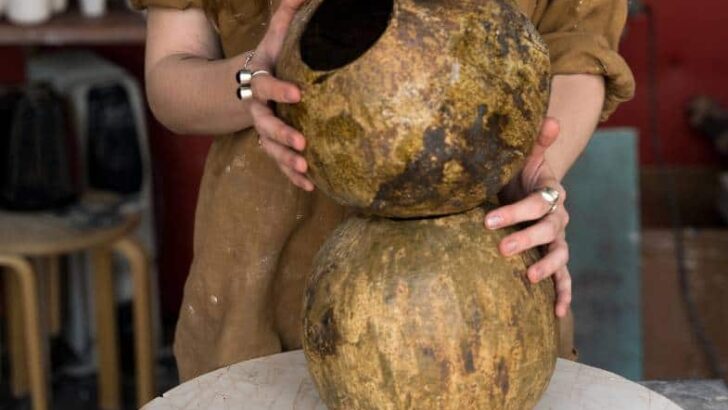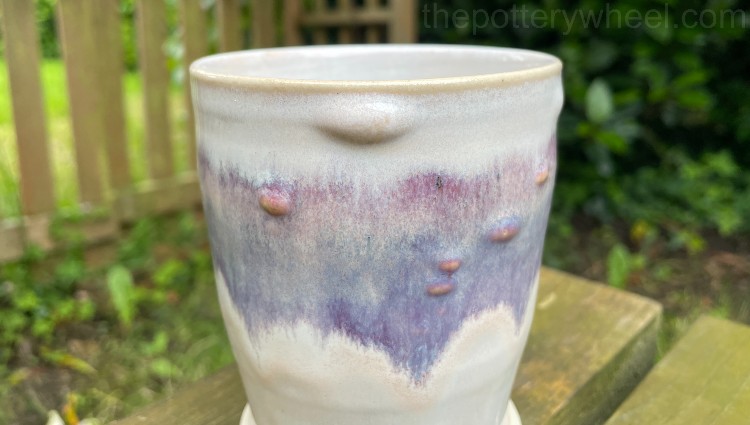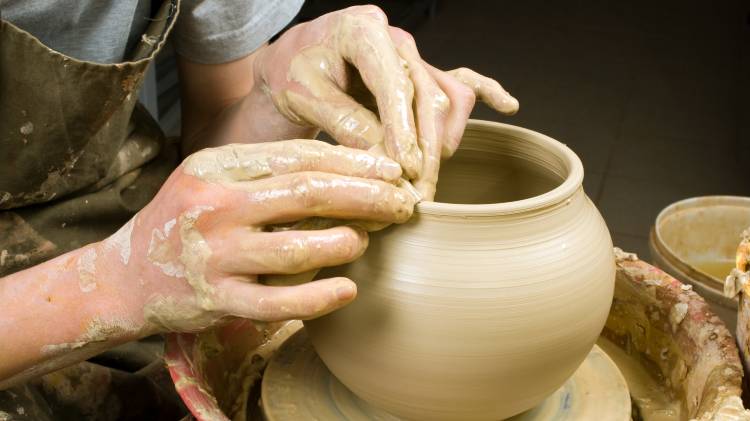Coil pottery is a diverse technique that has been adapted to suit the styles of a wide range of ceramic artists. This article takes a look at some famous coil pottery artists and their own individual way of hand-building pottery. You will see that the methods used and the ceramics produced vary widely between each potter.
I have ordered the list of coil pottery artists alphabetically, rather than trying to use any other criteria. You can browse each artist as they appear on the list. Or you can click on the names listed below to jump to a particular potter. Either way, I hope you find some inspiration in their work.
Famous Coil Pottery Artists
- Gordon Baldwin
- Elizabeth Fritsch
- Louise Goodman
- Ewen Henderson
- Ladi Kwali
- Maria Martinez
- Andrea Moon
- Nampeyo
- Siddig el Nigoumi
- Magdalene Odundo
- Grayson Perry
- Juan Quezada Celado
- Kristina Riska
- David Roberts
- Peter Stoodley
- Imogen Taylor Noble
- Judith Trim
- Monica Young
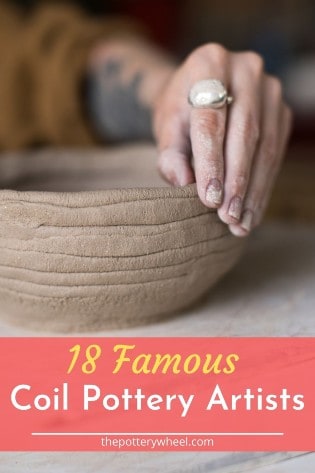
1) Gordon Baldwin
Gordon Baldwin was born in 1932 in Lincoln, UK.
He originally studied painting at Lincoln School of Art. However, he later studied at the Central School of Art and Design in London. It was here that he focused more on ceramics. In particular, in the 1950’s he became interested in hand-building pottery.
However, it was after he’d left the Central School that he started to think of himself as a sculptor. At this point, he sculpted in various materials. It wasn’t until later that he committed himself to working in clay.
Baldwin’s work in clay, which is influenced by surrealism, is hand-built using the coiling technique.
He builds large sculptural ceramic vessels. Individual coils of clay are added to the piece. They are joined to the previous coil using slip. He uses a combination of pinching the clay into shape and blending with a plastic rib as he builds.
Baldwin states that at times when he’s building some pottery, he will feel alienated from the work. He finds he has to push through this experience until he feels he is having a ‘dialogue’ with the vessel.
He uses drawing to help guide him when he makes vessels. Drawings will help him clarify what he wants a piece to look like. He sometimes uses drawing halfway through making a piece to help him decide how he wants it to evolve.
He works in earthenware and stoneware. Sometimes Baldwin fires a piece multiple times before he feels the piece is as it needs to be.
2) Elizabeth Fritsch
Elizabeth Fritsch was born in Shropshire, UK in 1940.
She uses stoneware clay to build fine, thin-walled coil pottery vessels. The surface of each side of the pot is smoothed and hand-painted with colored slips. These slips are matt colored with metal oxides or stains.
In her earlier work, she used slips that had a pale color. Then, later on, she used brighter blues and greens. Latterly, she has made monochrome-toned coil pots (source). Her painted designs are precise and the patterns are geometrical.
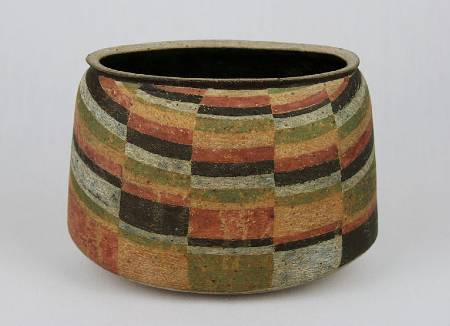
York Art Gallery, (CC BY-SA 3.0),
via Wikimedia Commons
3) Louise Goodman
Louise Goodman, also known as Louise Rose Goodman (born 1937) is a Navajo potter, who currently lives in Arizona.
Originally Goodman made mainly functional clay pots using the coiling technique. However, as the demand for functional ware declined in the 1980s she started to focus on decorative ware.
Her decorative pottery focuses on animal forms. Her work includes animal forms such as rams, chickens, and dogs. However, she is well known for making ceramic bears, because of their importance in the role of the Navajo community.
Her coil pottery is made by twisting coils of clay into a cylinder. Typically, Navajo coil pottery artists use the coil and scrape method of making coil pots. Many will scrape both the inside and outside of the pot smooth.
However, Goodman chose to smooth the inside of the pot, leaving the outside surface with a ridged rope-like surface. Like this piece in the picture below.
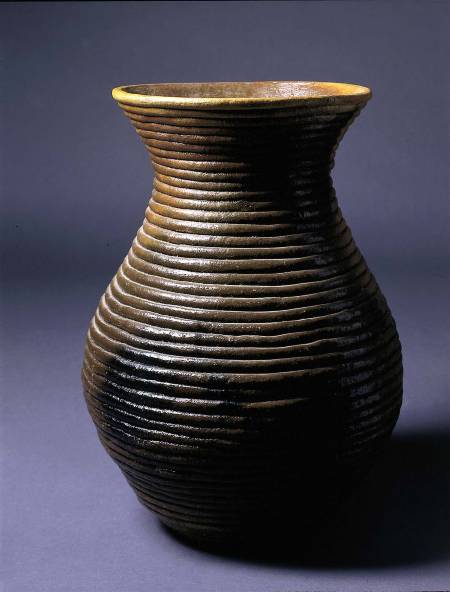
Public domain, via Wikimedia Commons
Goodman pit fires her work and finishes the fired pieces using a pinon pitch coating. This way of finishing pottery is a Navajo tradition (source).
A rag is dipped into a hot pine pitch using a stick and is then painted onto the pot. This seals the pot and gives it a glossy finish. It also affects the color of the surface, giving it either a brown shade or sometimes red or golden brown.
4) Ewen Henderson
Ewen Henderson (1934-2000) was born in Staffordshire UK and built his reputation as a potter in London.
He had an experimental approach that involved mixed different types of clay together in one piece of work. For example, he might combine porcelain, with terracotta and bone china (source).
He would then fire these patchwork pieces together at stoneware temperatures, and see what happened. (Blandino, B. 1984) He was interested in observing the effect of firing on different types of clay. And he wanted to push the clay to its limits.
When he was building coil pots, he would pinch the clay to make the base. Then he would build the walls of the pot upward using coils.
He would use the coils to sandwich different types of clay together. Sometimes these clays were naturally different in color. At other times, he would color them with oxides or stains.
He would put coil pots together fairly quickly. And, when the clay was still plastic, he would reshape the pot. He would use pinching and pulling to bring the pot to its final shape.
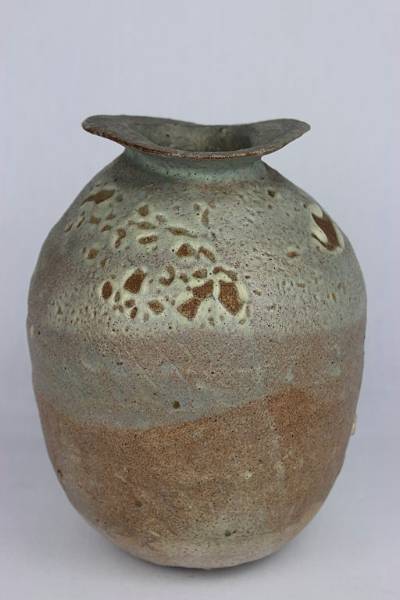
(CC BY-SA 3.0), via Wikimedia Commons
Henderson would sometimes raw glaze his pots. This means that he would apply glaze directly to the unfired clay, rather than bisque firing first. Unintended textures in glazes like crawling or running are often seen as a glaze problem.
However, Henderson thought that these features were part of the way the pot was supposed to be.
5) Ladi Kwali
Ladi Kwali (1925-1984) is one of the best known Nigerian coil pottery artists. She had a particular method of making coil pottery that was specific to the Gwari region of Nigeria.
Kwali placed a lump of clay on a circular saucer-shaped plinth. This was often made from a cabalash gourd, which is the hard skin/rind of a large bottle-shaped fruit.
Kwali would pound the center of the clay with her fist to make a basic bowl shape. Then she would pull the clay upward to form the start of a wall. The sides and rim of the pot would have an irregular shape.
Once the clay was at the right thickness she would start to add coils to the unevenly shaped rim.
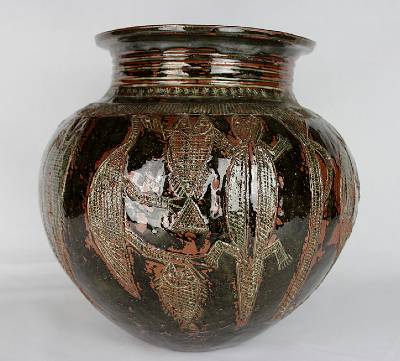
(CC BY-SA 3.0), via Wikimedia Commons.
Kwali would build her coil pots whilst standing up. She added the coils to the inside of the pot, positioning them below the top rim of the previous coil. She then dragged the clay up on a diagonal with her fingers. This would add to the height and width of the walls. She would walk around the pot as she worked on the clay.
When she got to the shoulder of the pot, she would start to draw the coils inward. The clay is drawn inwards on the diagonal to start to form the neck. A final coil was used to form an even rim on the pot.
Kwali decorated her coil pots by incising traditional images and symbols into the surface. She would draw the initial outline of the design onto the pot with a knife. Then she used a cylindrical wooden tool called a roulette to add texture to the drawn design.
6) Maria Martinez
Maria Martinez (1884-1980) was from San Ildefonso Pueblo on the Rio Grande Valley of New Mexico. She is one of the most internationally famous coil pottery artists.
Her coil pottery typically has a black on black style, with a glossy black background, decorated with matt black detail. Or vice versa, with a matt black background and black gloss design.
Her pottery is mostly medium-sized bowls, with a curved base. She started making her pot by flattening a circle of clay in her hands. This was then placed into a curved mold that supported the coil pottery as it was made. She knelt as she worked.
She would then build a straight cylinder of clay by adding coils to the base. Once she had built the cylinder she would smooth the inside surface. Martinez would then use tools and scrapers to shape the cylinder into the pot shape she wanted.
Instead of adding coils in a way that will create the shape, she completed the cylinder, then shaped the clay.
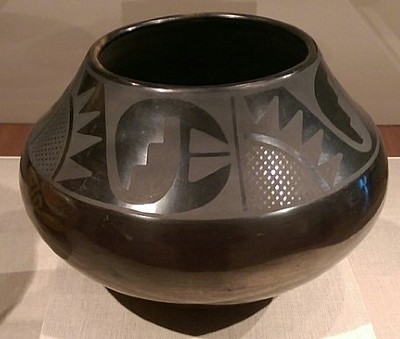
(CC BY-SA 3.0), via Wikimedia Commons
Once the pots had been formed, Martinez would coat them with several layers of slip using a cloth. This surface was then burnished using a smooth stone. The pieces were pit fired.
The black finish was created in a reduction atmosphere in the pit towards the end of the firing. This was achieved by covering the flames in the pit with dung and wood ash. Reducing the oxygen in the pit caused the slip to blacken.
Maria and her husband Julian would work together to create the blackened finish for the pots. The signature matt black decoration was made by painting slip on the burnished surface.
7) Andrea Moon
Andrea Moon was born in 1980 and grew up in Northwest Ohio, US. She is currently the Director of Education at Craft Alliance and a Visiting Lecturer in Ceramics at Washington University in St. Louis.
There are lots of different ways of making coil pottery. In spite of these differences, most often coils are positioned in concentric circles. Generally, coil pottery artists will build up the walls of a vessel by adding coils on top of one another. Andrea Moon’s approach to coil pottery is quite different.
Moon makes each of her sculptural coil vessels using between 650 and 1200 loops of clay (source). She begins the process of making her work by sketching out her ideas. Then she makes a batch of around 100 small loops of clay and begins to piece them together.
Each loop is carefully attached to the next, and she works from the top of the vessel to the base. She does this by starting with the rim on her work surface and working her way upwards. When she has worked her way through the coils she has prepared, she will make a further batch. Because of the number of coils involved, it can take a month or more to make a piece.
Her coil pottery takes the form of figurative work, vessels, and basket forms. She uses sandy stoneware clay and fires in a large gas kiln.
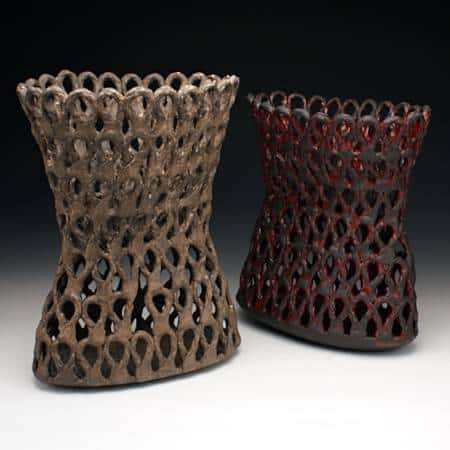
Image with kind permission by Andrea Moon
8) Nampeyo
Lesse Nampeyo (1859-1942) was a Hopi-Tewa potter. She lived in Arizona, US.
Nampeyo learned to make pottery from coil pottery artists of previous generations. In particular, she learned from her grandmother. However, she took a lot of her inspiration from ancient Sikyatki pottery that was being excavated by archaeologists working locally.
Her husband worked for an archaeologist who was digging at a local excavation site. He and Nampeyo would use shards of old pottery and draw sketches of the ancient work.
Then Nampeyo would use these sketches as inspiration for her pottery. As a result, her work is sometimes referred to as Hopi Revival pottery.
Nampeyo made her pottery out of Hano clay which was yellow in color when unfired. Once fired it would turn into an ivory color. She decorated her pots with slips made from a mixture of vegetable dye and iron.
The dye was painted onto the smooth surface of the coil pots using very fine brushes. These brushes were made from the separated fibers of a yucca plant.
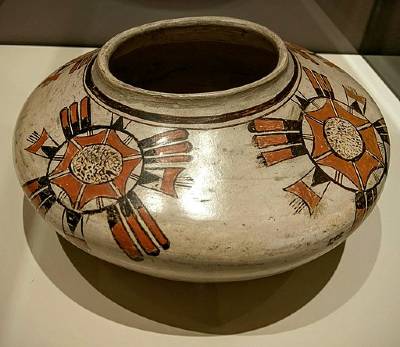
(CC BY-SA 3.0), via Wikimedia Commons.
9) Siddig el Nigoumi
Siddig el Nigoumi (1931-1996) was born in Sudan and moved to the UK in 1967.
Nigoumi was skilled at wheel throwing. However, his preference was to hand-build his pieces using the coil pottery technique. All of the pots that he made were made by coiling.
He would also make plates and platters using plaster molds, pressing slabs of clay into the mold. Nigoumi did produce some reduction fired glazed stoneware. However, his preference was working with terracotta earthenware. He fired his work in an electric kiln.
His earthenware pottery was left unglazed. Instead, he would decorate it with red or black slip. He used a particular slip that originated in the Nile Valley.
He would brush the slip onto his pottery. Then, before the slip was dry he would burnish his ware using a stone. Sometimes he would incise patterns onto his pieces. He used a combination of iconic English symbols mixed with African symbols in his incised designs.
Alternatively, he would sometimes create a smoked effect on his work. He would do this by dangling the piece on a stick over some sheets of burning newspaper. Then he would polish it with wax to bring up the shine again.
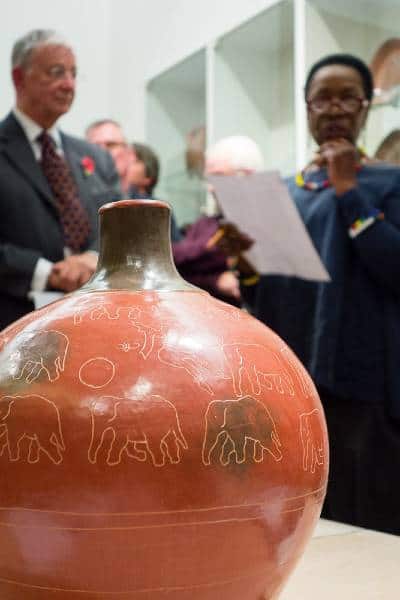
Image by Ben Boswell, used with kind permission.
10) Magdalene Odundo
Magdalene Odundo was born in Nairobi, Kenya in 1950. She moved to the UK in 1971 and continues to live there. She studied at the Cambridge School of Art and is one of the most famous coil pottery artists of modern times.
Coil pottery artists usually start off a piece with a slab of clay for the base. Or they might pinch a round-shaped base and build the coils around that. Odundo uses the latter method, pinching out the base of the pot. She then puts the pinched clay into a concave bisque fired form which supports the base. Her coil pots usually have a round base.
She then builds up the walls of the pot using short sections of flattened coils. These are smoothed on the inside and outside of her ware using her fingers and then gourd scrapers.
Her pots usually have a curved, smooth finish and often have an asymmetrical neck. She coats her ware with slip and then burnishes it. This process is repeated several times to create a high sheen on her work.
Odundo normally builds her work out of red terracotta. Her work is often fired twice. Areas of the red clay sometimes become blackened through reduction in the second firing.
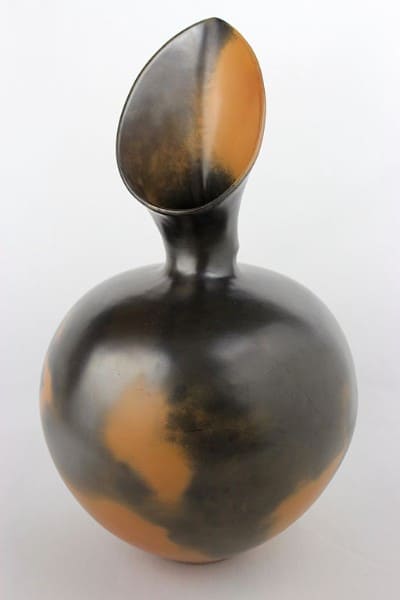
(CC BY-SA 3.0), via Wikimedia Commons
11) Grayson Perry
Grayson Perry was born in Chelmsford in the UK in 1960. His artwork is mainly ceramic vases, however, he makes tapestries as well. He is also a broadcaster and presenter, making documentaries about art and social commentary.
Perry coils his vases. He starts with a flat-rolled base of clay and builds the walls of the pot up using coils. These are then smoothed on the inside and out using a wooden modeling tool or spatula. He also uses metal ribs to smooth out the surface of his pot as he works.
Perry says he prefers the coiling technique because it is the easiest way to make large forms. It takes him around 2-3 months to produce a piece from start to finish. And he is normally working on around 10 pots at any given time.
His coil pottery is known for its detailed and meticulous designs. He uses a combination of drawing, painting, inlaying, carving, and stenciling.
Each stage in the design needs to be carefully planned and thought through. And he refers to his designs as being ‘triumphs of organization’ (source).
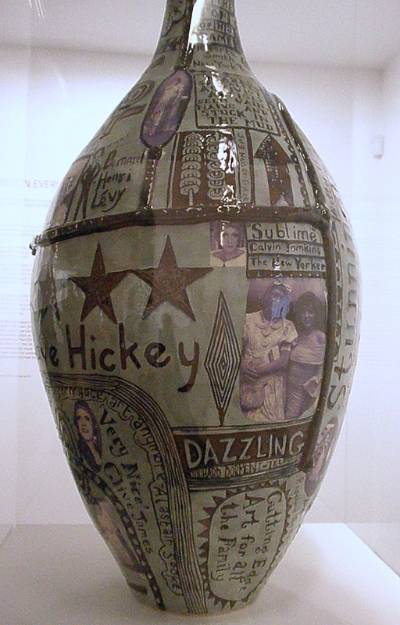
(CC BY-SA 2.0), via Wikimedia Commons.
Some of his work has an autobiographical theme to it, including references to his female alter ego ‘Claire’. He also refers to his own childhood experiences too.
His vases have a classical shape with a large belly, high shoulder, and tapered neck. However, his designs are often commenting on contemporary social issues.
12) Juan Quezada Celado
Juan Quezada Celado was born in 1940 in Chihuahua, Mexico.
The story of Juan Quezada’s journey towards being an internationally respected potter is an amazing one. He quit school early and started working in various jobs that involved spending periods of time in the local mountains.
Whilst he was wandering the mountains and collecting firewood he found fragments of old pre-Hispanic Mexican pottery.
Quezada had no formal training in ceramics. However, over time, he managed to work out how these ancient cultures had made their pottery. And he began to create pieces of his own work in a similar style.
After some time, his work became popular in America. His work is some of the most sought-after work made by coil pottery artists. Quezada taught his technique to family and local people in his small town of Mata Ortiz. This has grown into a pottery movement of its own known as Mata Ortiz Pottery.
Quezada and the Mata Ortiz Coil Pottery Artists
The Mata Ortiz Pottery technique involves starting with a slab of clay for the base. The slab is then put in a curved mold to support it as the sides are built.
Initially, the edges of the base are pinched upwards to begin the walls. Then coils of clay are added and pinched into shape to build the walls of the pot.
Once the coils are added, the pot is then scraped smooth using a hacksaw blade to finalize its shape. The ridges left from the blade are smoothed out. And the smoothed surface is burnished to a high sheen.
Part of the burnishing process is to sand the pot with a stone or deer bone. This surface is then covered with oil and polished. The detailed designs on the pot are very refined and painted onto the pot with brushes made of human hair.
13) Kristina Riska
Kristina Riska was born in Finland in 1960.
She makes large-scale work often around eight-foot tall. In spite of their size, her pieces have a fragile elegant appearance.
Because the coiling technique is quite a time-consuming process, making such large pieces can take a long time. It will generally take several weeks for her to make one piece.
Due to the size of the pieces she is working on, Riska stands as she coils. When building her pieces, she scores into the edge of the clay with a craft knife. She then moistens the clay with slip and pinches a coil onto the scored edge.
Then she blends the coil onto the clay with her thumb, blending on both surfaces. Her work is positioned on a rotating plinth which she turns as she blends. Once the coil is attached, she smooths the surface with a metal rib tool. The attached clay is then pinched some more to form the shape of the piece.
Once the piece is formed she decorates the surface of the pot with various textures. These textures can look like tree bark or fabric. The same texture tends to cover the whole large surface area of the piece.
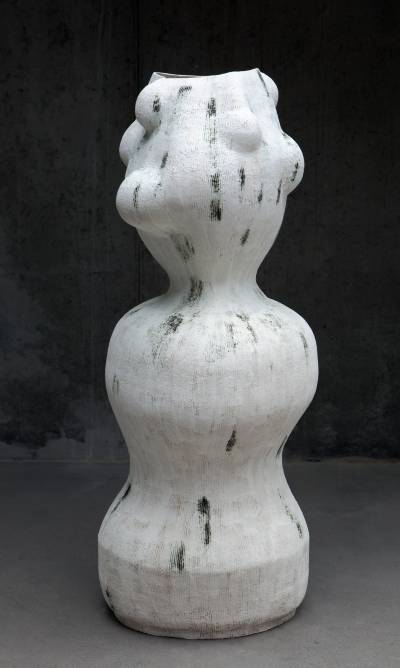
Image courtesy of Hostler Burrows.
14) David Roberts
David Roberts is a British potter, known for making large-scale raku ceramics.
Raku ceramics are withdrawn from the kiln when they are hot. The pieces are then placed into combustible material and covered in a container. This reduces the amount of oxygen in the surrounding atmosphere. The reduction atmosphere has an impact on the overall finish of the pot.
Because the pot is removed when hot, raku pottery needs to be made from clay that can withstand thermal shock. As such Roberts uses grogged clay. He is known for building large vessels using the coiling technique. He begins his pots with a disc of clay as the base. Then he adds successive coils to build up with walls of the piece.
When adding coils he presses the coils directly from above leaving a dimpled texture on the freshly added coil. He uses coils that are around 1cm in thickness and adds about two or three coils before joining them. He blends them by pulling the clay upwards on the inside and outside surface.
To shape his pots, Roberts positions his coils carefully as he builds the walls of the pot. Then he spins the banding wheel and shapes the pot, tidying up the surface with a metal scraper.
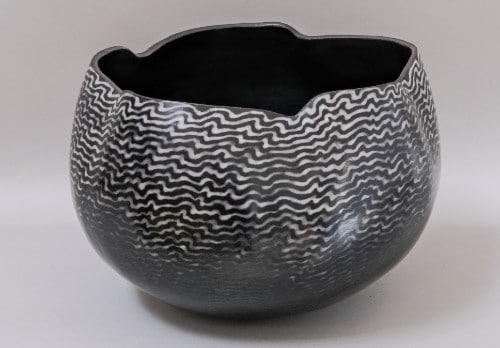
Image used with kind permission by David Roberts
Inspiration
Robert’s pottery is inspired by nature and geology. He states that ‘the linear patterns on the vessel’s surface can be simultaneously a reference to rock strata and an abstract means of exploring and articulating the complex interweaving of parabolic curves that make up the form of a coil built vessel” (source).
Roberts bisque fires his work in an electric kiln before raku firing his pottery. The raku technique that he uses is called naked raku. For more information on naked raku, check out this article.
15) Peter Stoodley
Peter Stoodley (1920-1990) was born in Bournemouth, UK.
His most well-known pieces are large hand-built garden pots or planters, that have been inlaid with slip. When forming his coil pots, Stoodley started with a disc of clay. This disc had been rolled out and then flattened further with the heel of his hand.
Then the walls are built up adding individual coils on top of each other. He would drape the coil onto the flat base. The coil would then be joined to the base by pressing the clay of the coil into the base.
Stoodley would position the coils carefully to create the form he wanted. That way, when the coils had been added, the pot was shaped as he wanted it to be.
He would then use a wooden paddle to beat the pot. This would refine the shape, rather than alter it in any significant way.
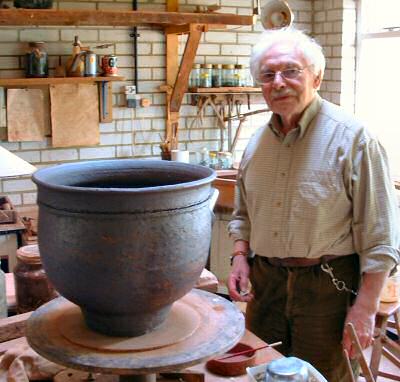
Image used with kind permission by Mike’s Pots.
Once the pot had been formed, he would decorate it by scoring into the surface with a hacksaw blade. Then he would paint black or white slip onto the incised surface.
Once the piece was leather hard, he would scrape away the high points of the surface. This would leave the slip in the incised areas, and expose the clay where the slip had been scraped away. This is similar to the Mishima technique.
Stoodley was influenced by the African pot making tradition. In particular, he was impressed by the work of Ladi Kwali. He was struck by the “skill and speed” (source) with which she coiled her pots.
16) Imogen Taylor Noble
Imogen Taylor Noble is a British ceramicist, she lives and works in Devon, UK.
Taylor Noble uses a combination of pinching and coiling to make her pottery. She starts with a circular dome of clay on a banding wheel. She presses her knuckles into the clay to beat it into a hollowed-out form for the base.
Then using her fingers, she smooths the inside of the base. She also pinches up the outside edge of the base to thin it out and shape it. Once the base is the right size and shape, she tidies up the edge with a craft knife.
This gives her an even surface to add her first coil. The purpose of starting a pot this way is so that larger forms can support their own weight. This means that she can work relatively quickly.
She uses flattened coils of clay to build up even thin walls. The flat coils are about an inch wide and are blended on with her fingers. When the pot has been built, Taylor Noble smooths out the surface with a piece of coconut shell.
The stoneware clay she uses sometimes contains pumice and oxides. These additions encourage the random effects of firing.
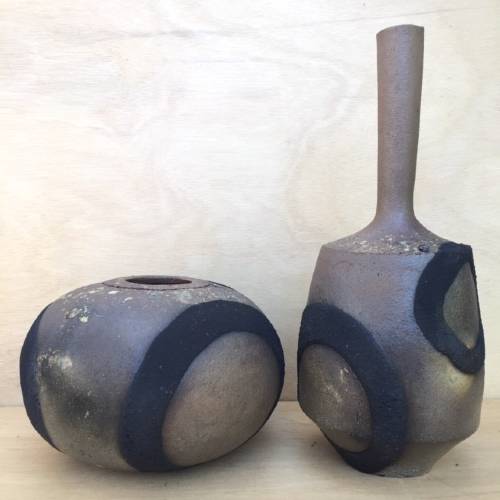
Courtesy of Imogen Taylor Noble. Instagram @Taylornoble_ceramics.
Recent Developments
For a period of time, Taylor Noble fired her pots in a large saggar in a gas kiln. The large kiln enabled her to make bigger pieces, some of which are three and a half feet tall.
Since moving from Whitstable to Devon on the South West edge of Dartmoor, the way she works has evolved. Her aim is to move away from using fossil fuels where possible.
She is currently building an energy-efficient wood kiln in an effort to make her practice more sustainable.
Taylor Noble’s work is about her relationship to the place and the materials natural to that environment. For example, on the coast in Whitstable, she would fire her pots with seaweed and oyster shells. These materials were readily available locally.
Since moving to Devon, the starting points of her work are the stones and bedrocks of the local landscape. She also uses local clays in all their forms. She describes her approach as ‘pragmatic and experimental, using what is available, affordable and local’.
17) Judith Trim
Judith Trim, also known as Judy (1943-2001) was a British potter born in Cambridge UK.
She studied art at the Bath Academy of Art, Corsham, and taught for some time after that. During that period of time, she focused on teaching rather than developing her own pottery. However, in her 30’s she began to concentrate in a more focused way on her own artwork.
At this time, she moved increasingly towards making pieces out of earthenware clay using the coil pottery technique.
She also developed a preference for more primitive ways of firing pottery such as sawdust firing. Trim’s pit-fired, burnished is known for being decorated in a precise way with luster paints.
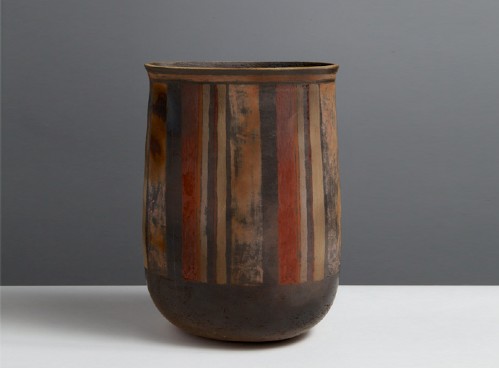
With kind permission from The Anthony Shaw Collection
Her pieces were often round bowls, tall bottles with long slim necks, and teardrop-shaped jars.
She felt that these elegant curved shapes represented something about the feminine principles of ‘holding and preserving’. And the smooth polished surface of the coil pots was a way of expressing “warmth, generosity, hope, and calm”. (E.Cooper source)
18) Monica Young
Monica Young (1929-2004) was born in Paris and moved to England in 1938.
Young trained originally as a painter and became a self-taught ceramicist in her 40s. She is known for making very large forms. In fact, her most well-known work is very large pots that sometimes stood as tall as the artist herself. She made these pieces using the coiling technique.
Her studio was in Yorkshire in the UK and her work achieved recognition in the latter part of her life. Her large forms have become collector’s items.
Young said that she chose to coil because it was the “only way I know to make large pots”. (Blandino 1984) Her later pieces have an elegant tulip-shaped form, with gentle curves. She would form the shape as she added her coils.
If she wanted to correct the shape of her pot after adding coils, she would beat it from the inside. Because of the size of her work, she would shape and reshape her work as she built the form upwards. The beating of hand-built pottery by coil pottery artists is often done using a wooden paddle.
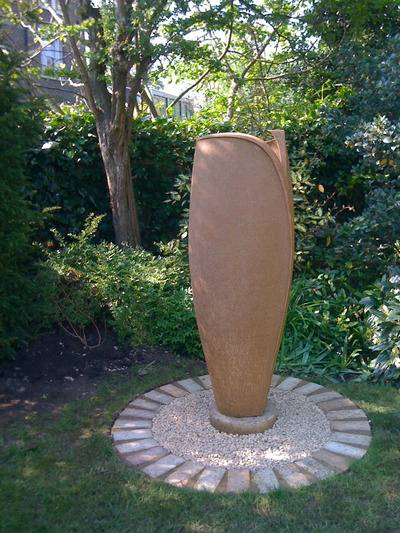
Image with kind permission from Maureen Michaelson.
Young’s Coil Pottery Technique
Her method was to start with a flat disk base. She then rolled out clay and formed the coils onto the base. Young used crank clay, which contains course silica grog, and is good for sculptural work. She fired her coiled pieces at a stoneware temperature.
Because of the size of her work, which was very tall, she would use large coils. Typically, these coils were thick, long, and heavy. These coils, cannot, because of Young’s petite stature been easy for her to work with.
Her pots are unglazed and have the gritty grained surface of grogged crank clay. The gritty texture of the clay was enhanced because Young scraped the surface of her work with a ‘Surform’ blade. These blades have a rasp-like effect.
After the clay dried, Young would sandpaper her work, with the intention of making the surface even more textured. She then rubbed chalk into the surface to darken the color of the clay. It was then fired in a reduction atmosphere at 2381F (1305C).
Final Thoughts on Famous Coil Pottery Artists
This list of famous coil pottery artists is by no means exhaustive. There are many other potters who have used and adapted this technique to suit their own way of working. In researching this article, I was overwhelmed by the number of amazing potters who use the coiling technique. However, I had to be selective, otherwise, the article would have become impossibly long. I chose to include these particular coil pottery artists because I loved their work. Why not do some research yourself? You might be surprised by who uses the coil pottery technique.

